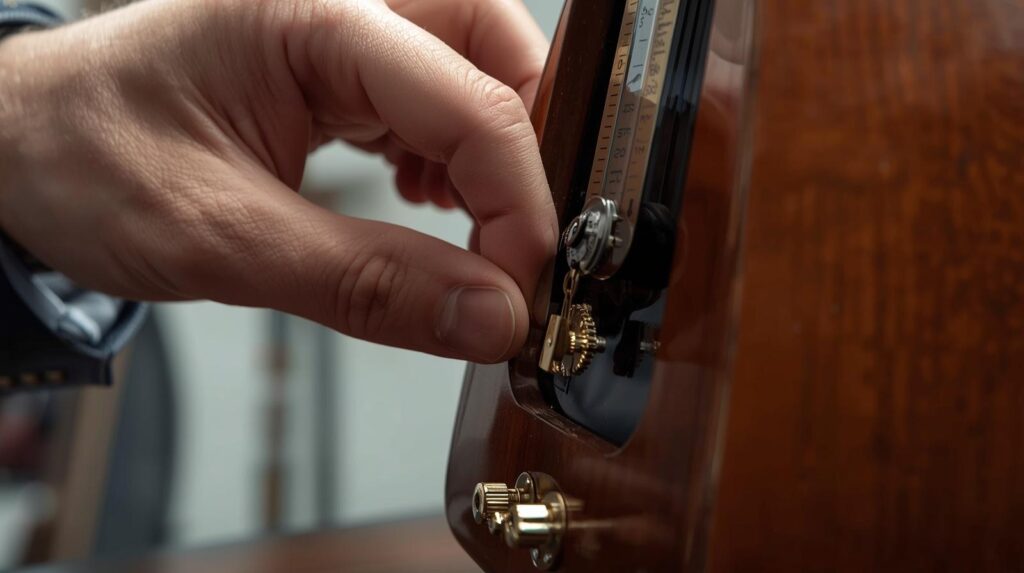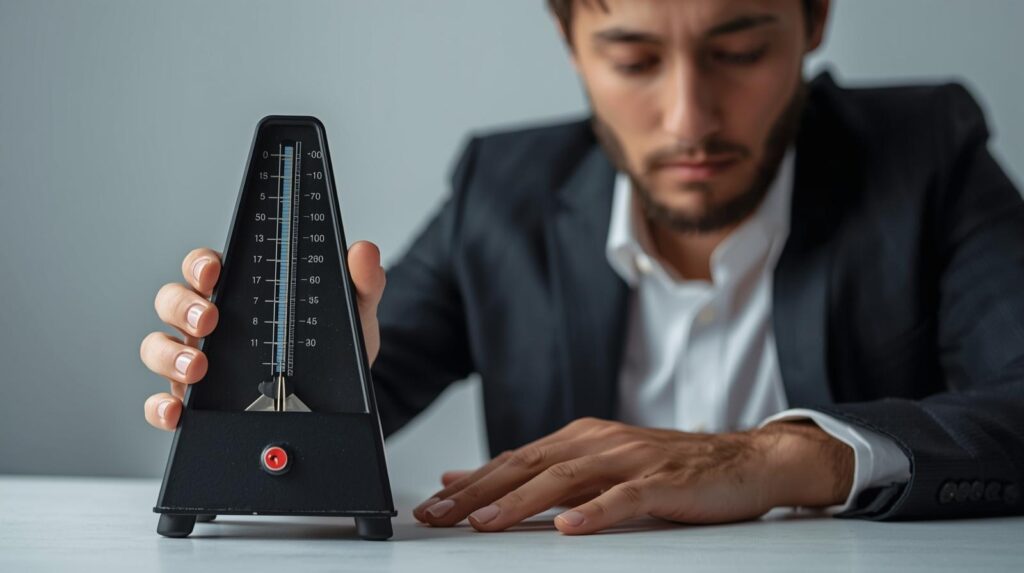How to Improve Your Rhythm and Timing in Music
Rhythm and timing are the foundation of all music. Whether you sing, play an instrument, or compose, your sense of timing determines how steady, expressive, and professional your performance sounds. Many musicians focus on melody, lyrics, or speed, but without accurate rhythm, even the most beautiful piece can feel unbalanced. Learning how to improve rhythm and timing in music is essential for every musician, as it enhances both technical precision and musical expression. Developing strong rhythm is a skill that anyone can learn. It requires focused practice and the right methods, including metronome training, tapping exercises, and structured rhythm drills. By understanding how to improve rhythm and timing in music, performers gain greater control, consistency, and confidence, ensuring that every note and beat aligns perfectly with the intended musical flow.
Understanding Rhythm and Timing in Music
For any musician, mastering timing in music is essential. Rhythm and timing are the foundation of every performance, whether you are singing, playing an instrument, or composing. Without accurate timing, even technically flawless pieces can feel unsteady, rushed, or awkward. Strong timing allows musicians to stay in sync with other performers, maintain a consistent tempo, and convey musical expression effectively.
Good timing also influences how music is perceived by audiences. A well-timed note, pause, or accent can transform a simple melody into a powerful performance. Musicians with developed timing skills can adapt to different styles, handle complex rhythms, and perform confidently in ensembles. Developing timing in music is not just about following a beat mechanically; it’s about internalizing the rhythm so that it becomes instinctive.
Exercises such as metronome practice, clapping patterns, tapping drills, and rhythm syllables all contribute to strengthening a musician’s internal clock. By focusing on timing in music, performers gain greater control, coordination, and expressiveness. Ultimately, rhythm and timing are what separate good musicians from truly professional and captivating performers.

Why Rhythm and Timing in Music Matter for Musicians
A musician with strong rhythm can make even simple melodies sound powerful. On the other hand, a performer with weak timing may struggle to stay on track, making the music sound uneven.
Benefits of improving rhythm include:
More professional performance quality
Better collaboration in bands, choirs, and ensembles
Improved coordination between hands, fingers, and voice
Higher musical precision and clarity
Whether you play piano, guitar, drums, violin, or sing, rhythm is what ties all musical elements together.

Using a Metronome to Strengthen Timing in Music
A metronome is one of the most effective tools for improving timing in music. It provides a steady, unchanging beat that helps musicians stay in sync, maintain consistent tempo, and develop precision. Practicing with a metronome trains both your ears and your sense of internal rhythm, allowing you to play or sing with confidence, even in complex musical passages.
Start by setting the metronome at a comfortable, slow tempo. Focus on aligning every note perfectly with the click. As you gain accuracy, gradually increase the tempo to challenge your timing control. You can also experiment with advanced techniques, such as setting the metronome to accent only certain beats or practicing with silent intervals, which forces you to internalize the pulse more deeply.
Counting aloud while practicing with a metronome can further strengthen your internal sense of rhythm. Over time, the metronome becomes less of a guide and more of a confirmation that your timing is accurate. Consistent use of a metronome is a key exercise for mastering timing in music and developing the precision and confidence needed for professional-level performances.

Advanced Metronome Techniques to Master Timing in Music
Once you are comfortable with basic metronome practice, advanced techniques can significantly enhance your timing in music. These methods challenge your internal rhythm, improve precision, and prepare you for more complex musical situations. For example, you can practice with beat subdivisions, playing eighth notes, triplets, or sixteenth notes against a steady click. This helps you internalize smaller rhythmic units and maintain accuracy across fast passages.
Another technique is to set the metronome to accent only certain beats, such as beats 2 and 4 in a 4/4 measure. This encourages you to fill in the unaccented beats mentally, strengthening your internal sense of pulse. Practicing off-beat accents or syncopated rhythms with a metronome also improves adaptability and timing control in diverse musical genres.
You can further enhance your skills by alternating tempos, starting slow and gradually increasing speed while keeping perfect accuracy. Recording yourself while using these advanced metronome exercises allows you to identify and correct timing inconsistencies. By integrating these techniques into your practice routine, you’ll develop precise and reliable timing in music, enabling confident, professional-level performances across any style or setting.
Using Tapping Exercises to Improve Timing in Music

Using tapping to develop internal rhythm is a simple yet powerful technique that helps you feel the beat rather than just follow it. Internal rhythm is the ability to keep time even when there is no metronome, drummer, or accompaniment guiding you. To start, listen to a steady piece of music or a metronome click and gently tap your finger, hand, or foot to the beat. Focus on maintaining a smooth, consistent motion that matches the pulse. This physical connection between sound and movement trains your mind and body to synchronize naturally with rhythm.
Once you are comfortable tapping the main beat, challenge yourself by tapping off-beats or subdivisions, such as tapping twice or four times within every beat. This improves control and helps prevent rushing or dragging when playing more complex music. Another effective exercise is to tap while counting aloud, such as saying 1 – 2 – 3 – 4 or using rhythmic syllables. This reinforces your internal pulse and strengthens musical awareness.
Over time, tapping becomes second nature, helping you maintain steady rhythm even when performing without support. Whether you are practicing alone, playing in a band, or performing live, developing internal rhythm through tapping builds confidence, stability, and expressive timing in your music.
Body Rhythm Techniques to Enhance Timing in Music
The Body Rhythm Technique is another powerful method for improving coordination. This technique involves using different parts of the body to express rhythm—such as tapping your foot while clapping your hands or patting your chest while counting the beat. Begin with slow, steady movements, ensuring each action stays aligned with the underlying tempo. This physical involvement strengthens the connection between the mind, ear, and body, helping rhythm become natural instead of forced. Practicing body rhythm also improves stage presence and performance flow, as your entire body learns to feel the beat. With consistent rhythm drills and body rhythm training, your timing becomes steady, expressive, and musically confident.

Rhythm Drills for Accuracy and Coordination
Rhythm drills help train both the mind and body to move in sync with the beat, making your playing smoother and more controlled. The goal of rhythm drills is not speed, but consistency and awareness. Start by clapping or tapping simple patterns before playing them on your instrument. This removes the pressure of notes and allows full focus on timing. For example, practice clapping quarter notes, then eighth notes, triplets, and sixteenth notes while counting aloud. Counting strengthens beat awareness and prevents rushing or slowing down. Once comfortable, apply these patterns to scales or chord progressions, keeping the tempo steady at all times.
Another useful rhythm drill is to alternate between playing and resting. For instance, play one measure and rest the next while keeping the beat internal and steady. This builds internal pulse and reduces dependence on external sound cues. For coordination, tap your foot lightly while clapping or playing, ensuring both actions remain aligned with the beat. Over time, these drills help develop control, timing accuracy, and musical confidence. With consistent practice, rhythm becomes natural and stable, forming a strong foundation for expressive and professional performance.
Clapping Patterns

Clapping patterns are one of the most effective and beginner-friendly ways to develop a strong rhythmic foundation in music. When you clap a rhythm, you remove the complexity of notes, finger positions, or lyrics, allowing your full concentration to be on timing alone. This makes clapping an ideal starting point for improving rhythm. Begin with simple quarter-note patterns, clapping steadily while counting 1-2-3-4 to establish a clear sense of pulse. Once this becomes natural, move on to eighth-note and triplet patterns, paying attention to how evenly each clap falls within the beat. The key is to remain relaxed and consistent—avoid speeding up or slowing down.
To take clapping practice further, try alternating between strong and soft claps to mimic musical accents. For example, clap loudly on beat 1 and softly on the remaining beats to train dynamic awareness. You can also practice clapping along with a metronome or a simple drum track to develop steadiness. Group clapping exercises also help build listening skills, as you learn to synchronize with others. Over time, clapping patterns improve timing, internal beat awareness, and rhythmic confidence, forming a strong base for playing instruments, singing, or performing in ensembles.
Use Rhythm Syllables
Using rhythm syllables is a highly effective method for understanding and performing rhythmic patterns accurately. Rhythm syllables assign simple vocal sounds to different note values, making rhythms easier to count, speak, and internalize. Instead of relying only on visual note reading, you say the rhythm out loud, which trains your ear and body to feel the beat more naturally. For example, a basic system uses “Ta” for quarter notes, “Ti-Ti” for eighth notes, “Ta-a” for half notes, and “Ta-ka-di-mi” for sixteenth notes. Speaking these patterns aloud allows you to clearly hear where each note falls within the beat, reducing confusion and hesitation when playing.
To practice, start by clapping while saying the syllables slowly and clearly. Focus on staying steady rather than going fast. Once comfortable, apply the same syllables when practicing simple scales or short musical phrases. By doing this, you link rhythm with movement and sound, which strengthens timing awareness. Rhythm syllables also help prevent rushing or dragging, as the spoken pattern keeps your pace controlled. This technique is especially helpful for beginners, but even advanced musicians use rhythm syllables when learning complex passages. With consistent practice, rhythm syllables help you develop confident timing, better coordination, and a stronger inner sense of musical pulse.

Practice Scales in Rhythm
Practicing scales in rhythm is one of the most effective ways to build both technical skill and strong timing. Instead of playing scales quickly or without structure, performing them in clear rhythmic patterns trains your hands, ears, and mind to work together. Begin by choosing a scale you are already comfortable with. Set a slow tempo and play each note as quarter notes, ensuring that every note aligns evenly with the beat. Once this feels steady, shift to eighth notes, where you play two notes per beat, paying close attention to maintaining a smooth and controlled flow. This gradual progression helps your muscles learn consistency rather than speed.
Next, try playing the same scale in triplets and sixteenth notes, always keeping the tempo slow enough to maintain accuracy. You can also use rhythmic accents by emphasizing the first note of every four notes, which strengthens dynamic control. Practicing scales in rhythm helps develop even finger movement, prevents rushing, and improves clarity in performance. Over time, your timing becomes natural and reliable, allowing you to play more expressively. Whether you are a beginner or advanced musician, rhythmic scale practice is a powerful routine that builds confidence, precision, and professional-level musical control.
Counting Beats to Stay in Time
Counting beats is a foundational technique for maintaining accurate timing in music. It helps you stay aware of the pulse and structure of a piece, ensuring that every note is placed correctly within each measure. When musicians count beats, such as “1-2-3-4” in common time or “1-2-3” in triple meter, they create a steady internal framework that guides their performance. This internal counting becomes especially useful when the rhythm becomes more complex or when the tempo changes. By consistently counting, you develop a habit of aligning your playing with the underlying beat rather than relying on guesswork or instinct alone.
To begin, practice counting aloud while clapping or tapping the beat. This helps reinforce the connection between movement and timing. Once comfortable, try counting in your head while playing an instrument or singing. The goal is for the counting to become automatic, so you always feel the beat even when not vocalizing it. Additionally, practice switching between counting whole beats and subdividing beats—for example, counting “1 and 2 and 3 and 4 and”—which helps with faster passages and syncopated rhythms. Over time, counting becomes less of an exercise and more of a natural part of musical understanding, allowing you to perform confidently and consistently in any musical context.

Practice Routine to Improve Rhythm and Timing in Music
A structured practice routine is essential for developing steady rhythm and accurate timing. Begin your session with a simple warm-up focused on feeling the beat. Start by clapping or tapping a consistent pulse for one to two minutes. This helps your mind and body connect to the internal beat before moving on to more complex exercises. Next, practice with a metronome set at a comfortable tempo. Choose a scale, chord progression, or simple melody, and play it while keeping perfectly aligned with the metronome clicks. If you rush or drag, slow the tempo and rebuild control before increasing speed. Gradual improvement is more effective than forcing quick results.
After that, work on rhythm drills such as clapping patterns, percussion exercises, or vocalizing rhythm syllables. These reinforce your sense of timing independently from pitch. Then, incorporate subdivision practice by counting “1 and 2 and 3 and 4 and” or “1-e-and-a” to improve control over faster notes and syncopated rhythms. End your practice with real-music application: play along with backing tracks or songs, focusing on blending smoothly with the beat. This routine, done consistently, will strengthen your internal timing, build rhythmic confidence, and enhance your musical expression across all styles and instruments.

Common Rhythm Problems and How to Fix Them
Many musicians struggle with rhythm-related challenges, especially when learning to play in time consistently. One common issue is rushing, where a player gradually speeds up without noticing. This usually happens when a musician is overly focused on notes rather than pulse. To fix this, practice with a metronome and consciously breathe or relax your hands to maintain steady motion. Another frequent problem is dragging, where the tempo slows down unintentionally. This often occurs when the music feels difficult. The best solution is to slow the tempo and build confidence gradually before returning to full speed.
Some players also struggle with uneven subdivisions—for example, eighth notes that are not evenly spaced. To correct this, count rhythms out loud using syllables like “1-and-2-and” or “1-e-and-a” and tap along to internalize the spacing. Losing the beat is another issue, especially when playing complex or syncopated rhythms. Practicing body rhythm exercises such as stepping, clapping, and vocal counting helps strengthen internal timing. Recording your practice can also reveal timing irregularities you may not notice in real-time. Addressing rhythm problems takes patience, but with mindful practice and slow, steady progress, any musician can develop strong rhythmic accuracy and confidence.
Final Thoughts
Improving rhythm and timing is not something that happens overnight; it develops gradually through consistent practice and mindful listening. Rhythm is the foundation of all music, and strengthening it enhances every aspect of your playing—from performing confidently to communicating better with other musicians. By using tools like metronomes, tapping exercises, clapping patterns, and rhythm syllables, you train your body and ear to stay aligned with the beat. The key is patience and repetition. Practicing slowly and steadily allows your timing to become natural rather than forced. It’s also helpful to listen to a wide variety of music and pay close attention to how rhythms are structured and expressed across different genres. Remember that rhythm is as much a physical feeling as it is a musical concept, so involve your body by stepping, moving, or lightly nodding to the beat while practicing. The more you internalize the pulse, the easier playing in time becomes. Whether you are a beginner or an experienced musician, focusing on rhythm builds confidence, improves musical expression, and leads to more satisfying performances. Keep practicing, stay aware of your timing, and let rhythm become a natural part of how you experience and create music.
For more information and exciting resources about learning music, visit our website at The Mystic Keys. For more music content and exciting offers follow us on
Facebook, Instagram, YouTube, LinkedIn, Twitter, Pinterest, and Threads.








